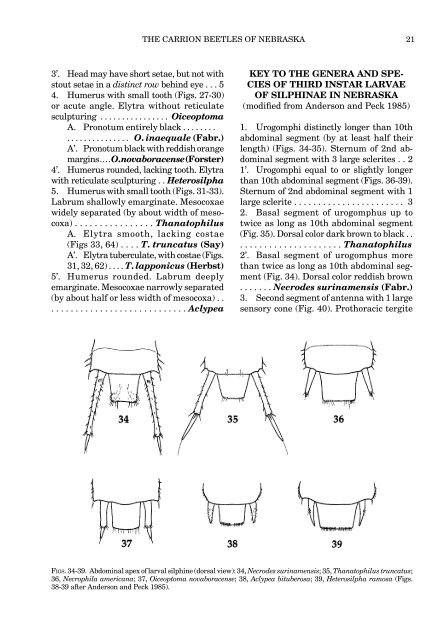Download full text - University of Nebraska State Museum
Download full text - University of Nebraska State Museum
Download full text - University of Nebraska State Museum
Create successful ePaper yourself
Turn your PDF publications into a flip-book with our unique Google optimized e-Paper software.
3’. Head may have short setae, but not with<br />
stout setae in a distinct row behind eye . . . 5<br />
4. Humerus with small tooth (Figs. 27-30)<br />
or acute angle. Elytra without reticulate<br />
sculpturing . . . . . . . . . . . . . . . . Oiceoptoma<br />
A. Pronotum entirely black . . . . . . . .<br />
. . . . . . . . . . . . . . . O. inaequale (Fabr.)<br />
A’. Pronotum black with reddish orange<br />
margins . . . . O. novaboracense (Forster)<br />
4’. Humerus rounded, lacking tooth. Elytra<br />
with reticulate sculpturing . . Heterosilpha<br />
5. Humerus with small tooth (Figs. 31-33).<br />
Labrum shallowly emarginate. Mesocoxae<br />
widely separated (by about width <strong>of</strong> mesocoxa)<br />
. . . . . . . . . . . . . . . . Thanatophilus<br />
A. Elytra smooth, lacking costae<br />
(Figs 33, 64) . . . . T. truncatus (Say)<br />
A’. Elytra tuberculate, with costae (Figs.<br />
31, 32, 62) . . . . T. lapponicus (herbst)<br />
5’. Humerus rounded. Labrum deeply<br />
emarginate. Mesocoxae narrowly separated<br />
(by about half or less width <strong>of</strong> mesocoxa) . .<br />
. . . . . . . . . . . . . . . . . . . . . . . . . . . . Aclypea<br />
THE CARRION BEETLES OF NEBRASKA 21<br />
Key TO The GeNeRA AND SPe-<br />
CIeS OF ThIRD INSTAR lARVAe<br />
OF SIlPhINAe IN NeBRASKA<br />
(modified from Anderson and Peck 1985)<br />
1. Urogomphi distinctly longer than 10th<br />
abdominal segment (by at least half their<br />
length) (Figs. 34-35). Sternum <strong>of</strong> 2nd abdominal<br />
segment with 3 large sclerites . . 2<br />
1’. Urogomphi equal to or slightly longer<br />
than 10th abdominal segment (Figs. 36-39).<br />
Sternum <strong>of</strong> 2nd abdominal segment with 1<br />
large sclerite . . . . . . . . . . . . . . . . . . . . . . . 3<br />
2. Basal segment <strong>of</strong> urogomphus up to<br />
twice as long as 10th abdominal segment<br />
(Fig. 35). Dorsal color dark brown to black . .<br />
. . . . . . . . . . . . . . . . . . . . . Thanatophilus<br />
2’. Basal segment <strong>of</strong> urogomphus more<br />
than twice as long as 10th abdominal segment<br />
(Fig. 34). Dorsal color reddish brown<br />
. . . . . . . Necrodes surinamensis (Fabr.)<br />
3. Second segment <strong>of</strong> antenna with 1 large<br />
sensory cone (Fig. 40). Prothoracic tergite<br />
Fi g s. 34-39. Abdominal apex <strong>of</strong> larval silphine (dorsal view): 34, Necrodes surinamensis; 35, Thanatophilus truncatus;<br />
36, Necrophila americana; 37, Oiceoptoma novaboracense; 38, Aclypea bituberosa; 39, Heterosilpha ramosa (Figs.<br />
38-39 after Anderson and Peck 1985).
















